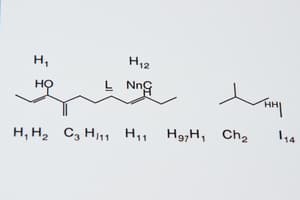Podcast
Questions and Answers
Quel est le suffixe utilisé pour les composés contenant un groupe fonctionnel alcool, comme l'éthanol ?
Quel est le suffixe utilisé pour les composés contenant un groupe fonctionnel alcool, comme l'éthanol ?
- -ane
- -al
- -yl
- -ol (correct)
Comment les atomes de carbone dans la chaîne carbonée la plus longue sont-ils numérotés dans la nomenclature des composés organiques ?
Comment les atomes de carbone dans la chaîne carbonée la plus longue sont-ils numérotés dans la nomenclature des composés organiques ?
- De manière à ce que le numéro de l'atome de carbone attaché au groupe fonctionnel soit le plus bas possible (correct)
- En ordre décroissant
- Dans un ordre aléatoire
- De manière à ce que le numéro de l'atome de carbone attaché au groupe fonctionnel soit le plus élevé possible
Quelle est la règle concernant la numérotation des branches dans les composés organiques avec des ramifications ?
Quelle est la règle concernant la numérotation des branches dans les composés organiques avec des ramifications ?
- Les branches ne sont pas numérotées du tout
- Les branches sont numérotées de manière à ce que le carbone de ramification ait le numéro le plus bas possible (correct)
- Les branches sont numérotées de manière à ce que le numéro du carbone de ramification soit le plus élevé possible
- Les branches sont numérotées de manière aléatoire
Quel préfixe est utilisé pour les composés ayant trois atomes de carbone selon la nomenclature organique ?
Quel préfixe est utilisé pour les composés ayant trois atomes de carbone selon la nomenclature organique ?
Quel suffixe est utilisé pour les composés contenant un atome de chlore lié à un atome de carbone dans la nomenclature des composés organiques ?
Quel suffixe est utilisé pour les composés contenant un atome de chlore lié à un atome de carbone dans la nomenclature des composés organiques ?
Pourquoi la nomenclature chimique est-elle essentielle en chimie selon le texte ?
Pourquoi la nomenclature chimique est-elle essentielle en chimie selon le texte ?
Quel est le système utilisé pour nommer les composés chimiques en fonction de leurs structures et de leurs propriétés?
Quel est le système utilisé pour nommer les composés chimiques en fonction de leurs structures et de leurs propriétés?
Qu'est-ce que le groupe fonctionnel dans un composé chimique?
Qu'est-ce que le groupe fonctionnel dans un composé chimique?
Quel est le préfixe utilisé pour indiquer un composé avec trois atomes de carbone?
Quel est le préfixe utilisé pour indiquer un composé avec trois atomes de carbone?
Que signifie le suffixe utilisé dans la nomenclature des composés organiques?
Que signifie le suffixe utilisé dans la nomenclature des composés organiques?
Dans un composé tel que l'éthanol, quel est le groupe fonctionnel?
Dans un composé tel que l'éthanol, quel est le groupe fonctionnel?
Qu'est-ce que la chimie organique étudie principalement?
Qu'est-ce que la chimie organique étudie principalement?
Study Notes
Chemical Nomenclature
Chemical nomenclature is a system used to name chemical compounds based on their structures and properties. It is an important tool for chemists to communicate about the substances they study. This article will focus on the nomenclature of chemical compounds and the principles that guide their naming.
Organic Compounds
Organic chemistry is the study of compounds that contain carbon. These compounds are usually named using the International Union of Pure and Applied Chemistry (IUPAC) system. The IUPAC system is based on the structure of the compound and uses a set of rules to create a standardized name for each compound.
IUPAC Naming Rules
The IUPAC system has a set of rules that must be followed when naming organic compounds. These rules include:
-
Functional group: The functional group is the group of atoms that determines the properties of the compound. It is usually the group that reacts in a chemical reaction. For example, in the compound ethanol, the functional group is the alcohol group, which consists of an oxygen atom bonded to a hydroxyl group (-OH).
-
Prefix: The prefix is used to indicate the number of carbon atoms in the longest continuous chain of carbon atoms in the compound. For example, the prefix "eth" is used for compounds with two carbon atoms, such as ethanol.
-
Suffix: The suffix is used to indicate the type of functional group. For example, the suffix "-ol" is used for compounds with an alcohol functional group, such as ethanol.
-
Numbering: The carbon atoms in the longest continuous chain of carbon atoms are numbered in a logical order. The numbering should be done in such a way that the number of the carbon atom attached to the functional group is the lowest possible.
-
Branching: If there are branches on the carbon chain, the branches are numbered in a logical order. The branches are usually numbered in such a way that the branching carbon atom is given the lowest possible number.
Examples of Organic Compound Nomenclature
-
Ethanol: The compound has two carbon atoms and an alcohol functional group. The prefix "eth" is used for compounds with two carbon atoms, and the suffix "-ol" is used for compounds with an alcohol functional group. The name of the compound is ethanol.
-
Propyl chloride: The compound has three carbon atoms and a chlorine atom attached to the second carbon atom. The prefix "prop" is used for compounds with three carbon atoms, and the suffix "-yl chloride" is used for compounds with a chlorine atom attached to a carbon atom. The name of the compound is propyl chloride.
Conclusion
Chemical nomenclature is an essential part of chemistry, as it allows chemists to communicate about the substances they study. The IUPAC system is widely used to name organic compounds based on their structures and properties. By following a set of rules, chemists can create a standardized name for each compound, making it easier to understand and discuss their research.
Studying That Suits You
Use AI to generate personalized quizzes and flashcards to suit your learning preferences.
Description
Découvrez les principes de la nomenclature des composés chimiques, en mettant l'accent sur les composés organiques et les règles de dénomination de l'Union Internationale de Chimie Pure et Appliquée (IUPAC). Apprenez comment nommer les composés en fonction de leurs groupes fonctionnels, de la longueur de la chaîne carbonée, de la numérotation structurale et des ramifications.




